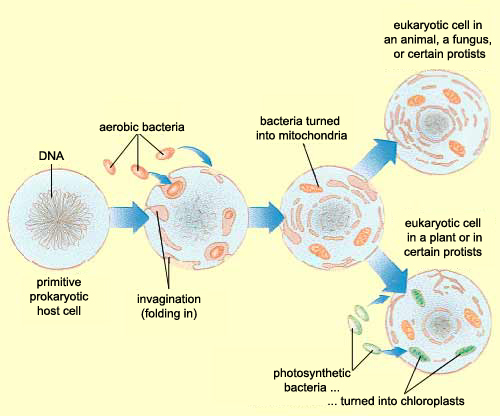 |
 |
 |
 |
 |
Produced
by the Population Genetics and Evolution class, Furman University |
||||
 |
 |
 |
 |
 |
Produced
by the Population Genetics and Evolution class, Furman University |
||||
 |
The
Precambrian: Endosymbiosis and Eukaryotic Cells |
 |
One theory
describing the origin of eukaryotic cells is that they arose through
endosymbiosis. Specifically, chloroplasts and mitochondria are decendants
of free-living prokaryotes that were engulfed by larger cells billions
of years ago (Caprette 2005). Gradually, the host cell formed a mutually-dependent
relationship with the engulfed cells, which eventually became chloroplasts
and mitochondria (Caprette 2005). There is much evidence supporting
this theory. Chloroplasts and mitochondria have a double-layered membrane
(other organelles such as the golgi complex and endoplastic reticulum
have one), supporting the notion of prokaryotic cells being engulfed
via endocytosis (Bio-Medicine 2009). Also, chloroplasts and mitochondria
have their own distinct set of DNA, RNA, and ribosomes. In fact, chloroplasts
and mitochondria do not follow the replication rules of the main cell
and replicate independently by using a method similar to binary fission
(Bio-Medicine 2009). Page by Lin-Lin Zhao |
 |
| The development of eukaryotic cells through endosymbiosis. The diagram also shows the formation of the nuclear envelope. The Evolutionary Origin of the Mitochondria | |
| Bio-Medicine
2009. Endosymbiotic Theory. Accessed 16 January 2010.
Caprette, D. 2009. Evolutionary Origin of Mitochondria. Accessed 15 January 2010. Delghandi, M., E.Utsic, and S. Krauss.1998. Saami Mitochondrial DNA Reveals Deep Maternal Lineage Clusters. Hum Hered. 48:108-114. . 17 January 2010. |